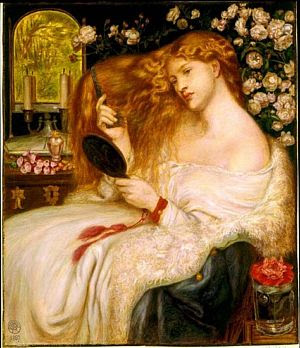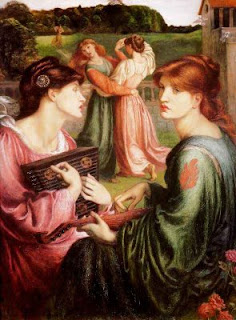As you will know by now my daughter Carnation-Lily-Lily-Rose has inordinately long hair and I have to admit that possibly my least favourite task is to brush her hair after washing it. With a large amount of conditioner and serum, we now have it down to a fine art and she barely murmurs or looks up from what ever dog-related program she is watching as I quickly rake it through and plait it. I have been criticised in the past for allowing her to have such long hair (people do say the strangest things) but I can’t bring myself to have it cut off, mainly because I never had long hair as a child and desperately wanted it. As I lacked the patience to let it grow, and my mother was firmly of the belief that girls looked better with short hair, I spent my formative years being shorn like a sheep every summer…
 |
| With my big brother. The past is a cruel, cruel place.... |
Anyhow, much rambling aside, I love the aesthetic of long hair, obviously influenced by my love of Pre-Raphaelite beauties with their long tresses, and I wanted to write something about the Victorian fetish of hair, after all isn’t that how Rossetti met Fanny, by letting down her hair? While perusing the images I could use, I found a definite subsection of ‘hair’ pictures; women combing their hair. Hello, I thought, what’s all that about…?
 |
Worldly Beauty (Lady Lilith) (1867) D G Rossetti
|
Here I am, back on Fanny, as it were, but she is a woman who worked her hair. Thinking of images of Fanny, I think of the one above or possibly Fazio’s Mistress as she plaits her hair, or the marvellous pastel with her great big plait over the top of her head. She gives the impression that her hair is heavy and powerful. Look at the thickness of it in the comb above! The way Rossetti paints his models with long, swan necks, they often look as if they are bowing under the weight of the hair. Lilith’s hair is symbolic of her self absorption, her utter self-interest: she isn’t just brushing her hair, she is displaying it. We watch as she performs this act, but she doesn’t give a monkey’s about us, she is too busy watching herself in the hand mirror. Here’s a question for you: do you think the arched shape behind her is a window or a mirror on her little table? I always thought it was a mirror, but that would beg the question why is she using the hand mirror when she has a larger mirror on her table just behind her? I think she is using her hand mirror to watch the back of her hair in the larger mirror so she can watch all aspects of her hair as she combs it through. Now that is self-absorption worthy of an appearance on a reality television programme….
There is a difference between a picture of a woman with beautiful hair and a picture of a woman tending to her beautiful hair, because it becomes about the act and our observance of it.
 |
The Glory of Womanhood Thomas Kennington
|
 |
Woman Combing Her Hair (1889) Louis Anquetin
|
Now here is a lady who is displaying her hair for us, the audience, or possibly more specifically, her owner. There is something somewhat veil-like about that shimmer of hair between the hank she is holding and the tresses beneath, which lends a very naughty air to this otherwise chaste picture. She is fully dressed and only combing her hair, but something in the colours, the expression and the delicacy of the posture lends a rather more meaningful mood to the scene. She is performing to others, this is preparation as display.
 |
Young Woman Combing Her Hair Brian Hatton
|
In terms of subject, Hatton’s girl is the same as Anquetin’s, both caught in the act of combing their hair, aware they are being observed. However, Hatton’s young lady looks faintly bemused that we watch her, puzzled by our interest. She lacks the glam or glitz of the red-headed madam above, but there is something in the detail of her hand that clutches the comb and the look over the shoulder that renders the subject beautiful and without artifice. This is literally not painted-up beauty, and she reminds me of the countless pencil and chalk images Rossetti did of the women he loved.
 |
| The Bower Meadow D G Rossetti |
 |
| Mermaid (1900) John William Waterhouse |
Let alone what people must have thought of this familiar image by Frederick Sandys…
 |
| Proud Maisie (1903) Frederick Sandys |
The hussy! That is both sexy and a little bit revolting, but links hair and sex in a very basic way, even though in Maisie’s case the emotion is frustration, denial which has led to a strange physical act upon herself. Oh, I think I’ll step away from that one sharpish before I’m forced to become any more explanatory and we all go blind. Quick, look at this…
 |
The Origins of the Combing Machine Alfred Elmore
|
That’s better. In conclusion, pictures of women combing their hair are about leaps forward in the eighteenth century textile industry and not about sex. Really, not at all. Not even Proud Maisie, especially if someone handed her a comb. Really, she’ll get split ends…
Great post and love that Hatton
ReplyDeleteYou can see from the frame in a larger image that's it's a mirror http://www.ulaola.com/blog/wp-content/uploads/2012/03/Rosetti-Dante-Gabriel-Lady-Lilith.jpg
ReplyDeleteI think maybe long hair is something to get used to young, otherwise growing it later it can be hard to get used to the weight.
Thanks for the comments. I think it's interesting that Rossetti left the mirror out of some versions of the image, but for the finished oil you get that double-mirror, as if to emphasise her utter physical infatuation with herself.
ReplyDeleteI don't mind the weight of having fairly long hair now, but I periodically get it all cut off because it's just habit. Lily is firmly attached to her long hair, and I hope she wants to keep it as it is glorious!
Lovely post, Middle daughter has long flowing locks. My wife has short hair now.... despite my greetings of "Hello BOB" in my best Blackadder tones upon her return from the salon, she never lets it grow to long before the next trip. I shall persevere until she grows it or buys a chain for me in "Purest Green " :-) Look forward to more of your entertaining blogs in 2017.
ReplyDelete